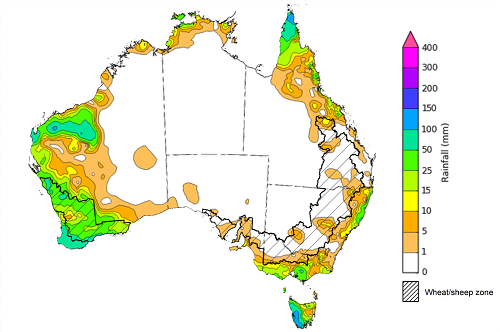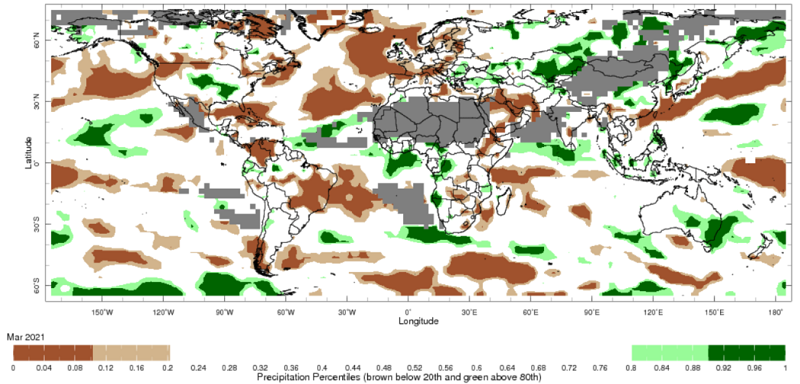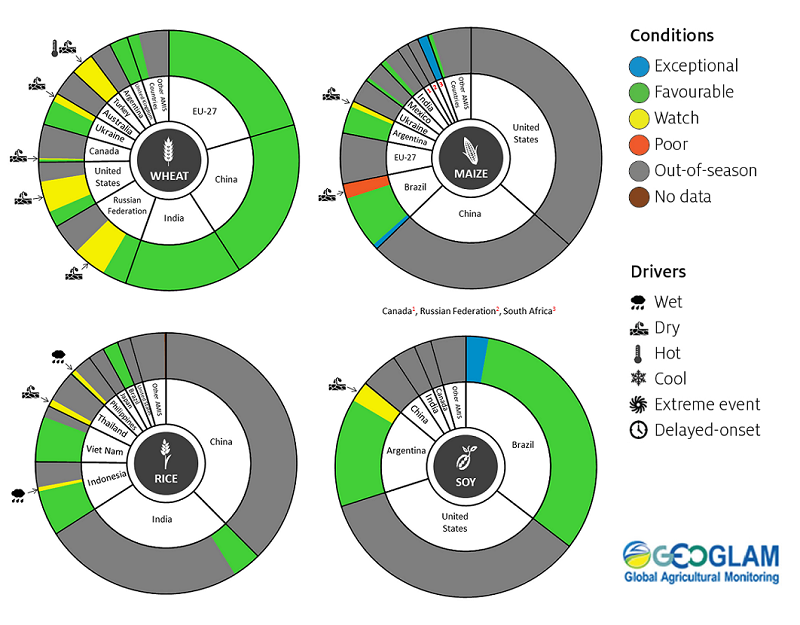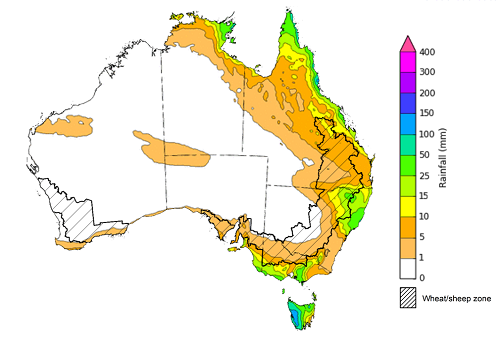Key issues
- During the week ending 14 April 2021, Tropical Cyclone Seroja and Tropical Cyclone Odette generated moderate to heavy rainfall across the west of Western Australia, while onshore flow and cold fronts generated moderate rainfall across isolated parts of Queensland and Tasmania.
- The substantial rainfall across cropping regions in Western Australia has likely provided an excellent start to the winter cropping season in Western Australia as sowing continues. The dry conditions in northern cropping regions of New South Wales and Queensland have been ideal for late summer crop harvesting, as well as field preparation and sowing of winter crops across southern Australia.
- As at 28 March 2021 global production conditions were generally favourable. However, a lack of precipitation has affected the production potential of wheat, corn, rice and soy in some key grain exporters and importers.
- March rainfall percentiles and current production conditions are similar to the global conditions seen during January, which were used to formulate ABARES forecasts of global grain supplies and world prices in its March 2021 edition of Agricultural commodities.
- The global climate outlook indicates that average to above average rainfall is more likely between May and July 2021 for most of the world’s major grain- and oilseed-producing regions. However, below average rainfall is expected for large parts of Brazil, the European Union and the western United States.
- Over the next eight days, troughs, cold fronts and onshore winds are likely to bring showers and storms to parts of northern and eastern Australia, while high pressure systems are expected to keep the majority of Australia dry.
- In Australia’s cropping regions, rainfall totals of between 10 and 50 millimetres are expected across parts of north-eastern New South Wales. Rainfall totals of between 5 and 15 millimetres are expected in cropping regions across much of Queensland, and isolated parts of southern Victoria and southern South Australia. The low expected rainfall totals across most cropping regions in Queensland and across southern Australia will allow harvesting of late sown summer crops, as well as field preparation and sowing of winter crops to continue without delay.
- Water storage in the Murray–Darling Basin (MDB) decreased by 59 gigalitres (GL) between 7 April 2021 and 14 April 2021. The current volume of water held in storage is 14,106 GL, which represents 56% of total capacity. This is 65% or 5,545 GL more than at the same time last year.
- Allocation prices in the Victorian Murray below the Barmah Choke increased from $75 per ML on 8 April 2021 to $101 per ML on 15 April 2021. Prices are lower in the Murrumbidgee due to binding of the Murrumbidgee export limit.
Climate
[expand all]
Rainfall this week
During the week ending 14 April 2021, Tropical Cyclone Seroja and the short lived Tropical Cyclone Odette generated moderate to heavy rainfall across the west of Western Australia. Onshore flow and cold fronts generated moderate rainfall across isolated parts of Queensland and Tasmania.
Rainfall totals of between 10 and 50 millimetres were recorded across isolated parts of eastern New South Wales, northern and eastern Queensland, southern Victoria and the north of the Northern Territory, and large parts of the west of Western Australia and Tasmania. Rainfall in excess of 50 millimetres was recorded across parts of far northern Queensland, the west of Western Australia and western Tasmania.
In cropping regions, rainfall of between 15 and 50 millimetres was recorded across much of Western Australia with rainfall up to 100 millimetres across isolated areas. Rainfall of between 5 and 15 millimetres was recorded across cropping regions in isolated parts of central and north‑eastern New South Wales, northern Queensland and southern Victoria. Little to no rainfall was observed across remaining cropping regions.
The substantial rainfall across cropping regions in Western Australia has likely consolidated upper and lower layer soil moisture profiles following the average or better rainfall during the start of the year. This is expected to provide an excellent start to the winter cropping season in Western Australia as sowing continues. The dry conditions in northern cropping regions of New South Wales and Queensland have been ideal for late summer crop harvesting, as well as field preparation and sowing of winter crops.
Rainfall for the week ending 14 April 2021
©Commonwealth of Australia 2021, Australian Bureau of Meteorology - Issued: 14/04/2021
Note: The rainfall analyses and associated maps utilise data contained in the Bureau of Meteorology climate database, the Australian Data Archive for Meteorology (ADAM). The analyses are initially produced automatically from real-time data with limited quality control. They are intended to provide a general overview of rainfall across Australia as quickly as possible after the observations are received. For further information go to http://www.bom.gov.au/climate/rainfall/
Global production conditions and climate outlook
Crop production is affected by long-term trends in average rainfall and temperature, interannual climate variability, shocks during specific growth stages, and extreme weather events (IPCC 2012). Some crops are more tolerant than others to certain types of stresses, and at each growth stage, different types of stresses affect each crop species in different ways.
The precipitation anomalies and outlooks presented here give an indication of the current and future state of production conditions for the major grain and oilseed producing countries which are responsible for over 80% of global production. This is an important input to assessing the global grain supply outlook.
March precipitation percentiles and current production conditions
As at the end of March 2021, precipitation was mixed for the world’s major grain and oil producing regions.
In the northern hemisphere, March precipitation was above average in parts of eastern China, far eastern Europe, Indonesia, central and eastern Kazakhstan, Malaysia, the Philippines, the central and east of the Russian Federation, Turkey and the central-east of the United States of America.
Precipitation was below average across parts of southern Canada, southern China and much of Europe. Precipitation was generally average across the remainder of major grain and oil producing regions in the northern hemisphere.
In the southern hemisphere, March rainfall was above average across parts of south-western Africa, central and south-eastern Australia and isolated parts of northern Brazil and central and southern Southeast Asia. Rainfall was below average across parts south-eastern Africa and south-western Argentina. Conditions improved across some major cropping regions in southern Brazil, however rainfall was below average across large parts of central Brazil. Rainfall was generally average across the remainder of major grain and oil producing regions in the southern hemisphere.
Global precipitation percentiles, March 2021
Note: The world precipitation percentiles indicate a ranking of precipitation for March, with the driest (0th percentile) being 0 on the scale and the wettest (100th percentile) being 1 on the scale. Percentiles are based on precipitation estimates from the NOAA Climate Prediction Center's Climate Anomaly Monitoring System Outgoing Precipitation Index dataset. Precipitation estimates for March 2021 are compared with rainfall recorded for that period during the 1981 to 2010 base period.
Source: International Research Institute for Climate and Society
As at 28 March 2021 global production conditions were generally favourable. However, a lack of precipitation has affected the production potential of wheat, corn, rice and soy in some key grain exporters and importers.
Conditions for wheat development were generally favourable in Canada, China, the European Union, India, United Kingdom and Ukraine. Reduced rainfall in parts of the Russian Federation, Turkey and the United States of America, and cold weather in Ukraine, has resulted in mixed conditions.
Conditions for corn in Argentina remained favourable for the early-planted crop and recent rainfall largely improved conditions for late-planted crop. In Brazil, a lack of rainfall during grain-filling has reduced yields for spring-planted corn in the south, however, conditions are favourable and exceptional for spring-planted corn in other regions and the sowing of summer-planted corn has been wrapping up under favourable conditions. Conditions for harvesting in India and for sowing in Mexico remained favourable, while conditions in South Africa were exceptional as harvest begun.
Conditions for rice were favourable in Brazil as harvest continued and in India as Rabi rice develops. In Indonesia, harvesting of wet-season rice was generally favourable, however earlier flooding in parts have impacted yields. Harvesting of early-sown dry-season rice started in the Philippines under mixed conditions as recent storms damaged crops in multiple regions. A lack of irrigation water in Thailand has resulted in mixed conditions for dry-season rice. Conditions were favourable in Vietnam for the harvesting of dry-season crop and for sowing of wet-season crop.
Conditions for soybeans in Argentina were mixed for early- and late-planted crops as some regions have experienced a lack of rainfall. As the early-planted crops are in critical grain developmental stages, further rainfall will be needed to ensure good yields. In Brazil, conditions have remained favourable as harvesting continues, with exceptional conditions in the north-east.
Crop conditions, AMIS countries, 28 March 2021
AMIS Agricultural Market Information System.
Source: AMIS
| Region | May-July rainfall outlook | Potential impact on production |
|---|---|---|
| Argentina | Average rainfall is more likely across most of Argentina and below average rainfall is more likely across parts of the east and south between May and July 2021. | Average rainfall across most of Argentina is likely to support the harvesting of cotton, corn, sorghum, rice, millet and soybeans, and the planting and development of wheat. |
| Black Sea Region | Ukraine - Average rainfall is more likely across most Ukraine. Kazakhstan - Average rainfall is more likely across most of Kazakhstan. The Russian Federation - Above average rainfall is more likely across parts of central and eastern Russia and below average rainfall is more likely across parts of far western Russia. |
Average or better rainfall across the Black Sea Region is likely to support spring wheat planting and development in the north, and the development of winter wheat and canola prior to harvesting in July and the planting of cotton, corn and sunflower in the south. |
| Brazil | Above average rainfall is more likely across parts of northern Brazil and below average rainfall is more likely across parts of southern Brazil between May and July 2021. | Below average rainfall across parts of southern Brazil may adversely affect the development of cotton and corn in the central-west and the planting and development of wheat in the south between May and July 2021. Conversely, below average rainfall across parts of Brazil is likely to allow harvest to proceed without delay for soybeans, cotton, millet, rice, sorghum and sunflower in the south and for corn and cotton harvest from June in the central-west. |
| Canada | Average rainfall is more likely for most of Canada and below average rainfall is more likely for parts of south-western Canada between May and July 2021. | Average rainfall is likely to support winter wheat development in Canada prior to harvest in June and the planting and development of spring wheat, canola, corn, soybeans and sunflower from May. |
| China | Above average rainfall is more likely across parts of northern China and below average rainfall is more likely across parts of western China between May and July 2021. | Average or better rainfall across much of eastern China is likely to support the development of winter wheat, spring wheat, canola, early rice and cotton, and the planting and development of single rice, late rice, corn, sorghum, soybeans, sunflower and nuts. |
| Europe | Below average rainfall more likely for much of Europe and above average rainfall is more likely for isolated parts of northern Europe between May and July 2021. | Below average rainfall across much of Europe may adversely affect the development of winter wheat, corn, cotton and sorghum between May and July 2021. In contrast, average or better rainfall across parts of northern Europe is likely to support the planting and development of corn, soybeans, sunflower and the development of winter wheat, spring wheat and canola. |
| South Asia (India) | Above average rainfall is more likely across much of India and below average rainfall is more likely across isolated parts of the north-eastern India between May and July 2021. | Above average rainfall across much of India is likely to benefit the planting and development of cotton, corn, sorghum, rice, millet, nuts and sunflower from June 2021. |
| Southeast Asia (SEA) | Above average rainfall is more likely for parts of southern Indonesia, Myanmar, Thailand and the Philippines and below average rainfall is more likely for parts of Cambodia, northern Indonesia and central Myanmar between May and July 2021. | Average or better rainfall across most of Southeast Asia is likely to benefit corn and rice planting and development from May 2021. Below average rainfall across parts of Cambodia, northern Indonesia and central Myanmar may adversely impact rice and corn production. |
| The United States of America | Above average rainfall is more likely for parts of the eastern US and below average rainfall is more likely for parts of the north-western and central US between May and July 2021. | Average or better rainfall across much of the eastern US is likely to support winter wheat, spring wheat, canola, cotton and rice development and the planting and development of corn, soybeans, nuts, sunflower and millet. Below average rainfall in the north-western and central US may adversely impact the development of these crops and pastures. |
Rainfall forecast for the next eight days
Troughs, cold fronts and onshore winds are likely to bring showers and storms to parts of northern and eastern Australia, while high pressure systems are expected to keep the majority of Australia dry.
Rainfall totals of between 10 and 50 millimetres are forecast for parts of eastern New South Wales, northern and eastern Queensland, southern Victoria, south-eastern South Australia, the north of the Northern Territory and eastern Tasmania. Rainfall totals in excess of 50 millimetres are forecast for parts of north-eastern Queensland and western Tasmania.
In Australia’s cropping regions, rainfall totals of between 10 and 50 millimetres are expected across parts of north-eastern New South Wales. Rainfall totals of between 5 and 15 millimetres are expected in cropping regions across much of Queensland, and isolated parts of southern Victoria and southern South Australia. The low expected rainfall totals across most cropping regions in Queensland and across southern Australia will allow harvesting of late sown summer crops, as well as field preparation and sowing of winter crops to continue without delay.
Total forecast rainfall (mm) for the period 15 April to 22 April 2021
©Commonwealth of Australia 2021, Australian Bureau of Meteorology - Issued: 15/04/2021
Note: This rainfall forecast is produced from computer models. As the model outputs are not altered by weather forecasters, it is important to check local forecasts and warnings issued by the Bureau of Meteorology.
Water
Water storages, water markets and water allocations - current week
The Tableau dashboard may not meet accessibility requirements. For information about the contents of these dashboards contact ABARES.
Commodities
Information on weekly price changes in agricultural commodities is now available at the Weekly commodity price update.




